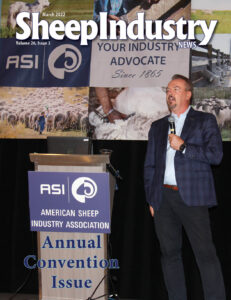CAT URBIGKIT
The Shepherd
Sheep producers have about 18 months to work with their veterinarians to get plans in place for the use of antimicrobial drugs when the need arises in their flocks, according to University of California-Davis specialist Roselle Busch, DVM.
When these drugs switch to prescription-only next year, producers will not be able to purchase the drugs at supply stores or online without a prescription, and the prescriptions will be served by licensed pharmacies.
Busch told the ASI’s Animal Health Committee that the U.S. Food & Drug Administration plans to transfer all medically important antimicrobial drugs for use in animals – both food-producing animals and companion animals – to availability only under the oversight of a licensed veterinarian. While the FDA has been phasing in the program in the last few years, remaining over-the-counter antimicrobials for animals will be transitioned to prescription-only by June 2023.
Livestock producers should work to establish veterinarian-client-patient relationships and flock health plans that outline treatment protocols for common conditions to ensure that producers are able to continue to provide needed care to their animals, Busch said.
The movement to restrict antibiotics is due to antibiotic resistance – recognized as a global threat to both public health and animal health. The consequence of such resistance means that simple infections are more difficult to treat, with longer treatment times, increased costs and deaths.
Scrapie
U.S. Department of Agriculture/Animal and Plant Health Inspection Service veterinarian Diane Sutton provided an update on the scrapie eradication program, noting that when the program began, it was estimated that about 1 in every 500 sheep in the United States was affected. The estimate is “now probably 1 in 100,000, but we can’t say that with certitude,” Sutton said.
Eradication of the disease will open pathways for exports of both sheep and goats, as well as increase productivity in the nation’s flocks.
Scrapie is a transmissible spongiform encephalopathy affecting sheep and goats that was detected in the United States after the import of a small group of sheep from the United Kingdom via Canada in 1942. Since the USDA’s slaughter surveillance started in 2003, the percent of cull sheep found positive at slaughter has decreased 99 percent. However, to declare the United States “scrapie free,” USDA must be able to prove that its surveillance program has conducted testing in all sheep and goat populations.
“Every time we get a new positive case, we lose years of progress in the program as well as millions of dollars in the industry,” Sutton said.
B. ovis
Brucella ovis is a primary cause of epididymitis in rams, reported Andrew Johnson, Ph.D., of Veterinary Medical Research and Development. It results in infertility and reductions in lamb yields in flocks. Screening for B. ovis routinely consists of palpating the scrotum of rams, followed by serology tests on animals with abnormalities, as well as some clinically normal rams. But with existing ELISA antibody tests, it is difficult to detect differences in exposure and clearing versus actual shedding of the virus. In most cases, rams that test positive are culled, since there is no cost-effective antibiotic treatment available and vaccination is not widely practiced.
But not all rams that test positive will develop clinical disease, so the economic impact of a more consistent test for B. ovis might prove substantial for management of individual rams.
Johnson reported that the major challenge is there are no standardized commercial ELISA test reagents available in the United States, and there have been discrepant results between different laboratories. That’s where VMRD comes in.
VMRD is a private company based in Pullman, Wash., that develops and manufactures veterinary diagnostic kits and related reagents. VMRD has standardized antigen and manufacturing controls for B. ovis ELISA reagent manufacturing. Johnson told the committee that four different labs conducted external validation tests, with results indicating that this is a sensitive assay with repeatable results.
Numerous diagnostic labs are now in the process of converting to using these reagents, so VMRD’s improvements to B. ovis testing stands to lessen the number of animals culled for being in the “suspect” zone when test results are received.
Electronic ID
Citing increased risk of foreign animal disease entering the United States, Cindy Wolf, DVM, of Minnesota spoke about transitioning to an electronic identification system for sheep, noting EID “would help us know where those animals were, where those animals are going, much more rapidly” than traditional record-keeping with paper and visual tags.
If EID were in place, it would automatically become part of the disease control program, Wolf said. Even if all producers aren’t ready to implement EID now, the sheep industry needs to be ready to protect the industry. To that end, the ASI Electronic ID Transition Working Group spent the last year examining the issue and preparing a report to the industry.
The working group recognized that real-time traceability is important to ensure the continuity of business for sheep producers should it be faced with a rapidly spreading disease. The only proven system that works for that is using low-frequency RFID tags, readers and software, such as those already used in regions such as England and Australia, and sporadically throughout the United States.
Wolf said the working group learned some basics from other countries, including that a subsidy for the program was necessary, as were mandates and educational campaigns. Other countries also demonstrated the benefits of the program, including preparedness for a foreign animal disease, their ability to market lamb meat using traceability, and increased productivity and profitability in their flocks.
While RFID systems are available and in use in the United States, the working group developed a list of concerns and impediments to setting up a national program, as well as a series of recommendations for moving the industry forward. Among its recommendations, the working group suggests that government cost-sharing in development and implementation of the program is necessary, and that there should be a phased-in approach to the program, with a state or region fully implementing the program within one year, before all states would transition to RFID within two years.




